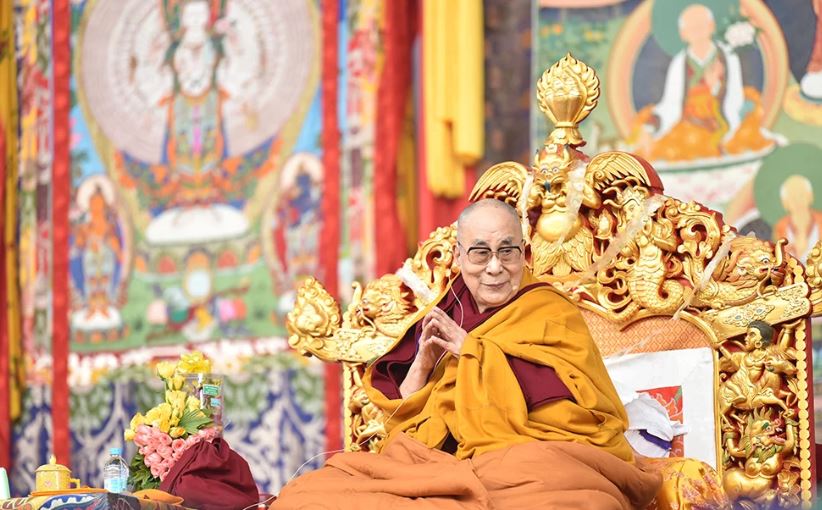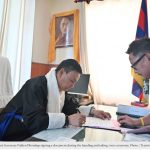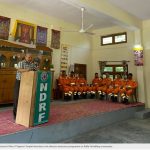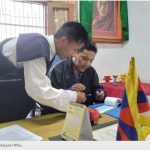Bodhgaya: After several days of cold and foggy weather across North India, the prospects this morning seemed brighter as His Holiness the Dalai Lama walked from the Tibetan Monastery, Ganden Phelgyeling, to the Kalachakra Ground. The Abbots of Ganden Shartsé and Jangtsé Monasteries and the Disciplinarian of Namgyal Monastery led the way wearing their yellow crested hats and carrying incense. His Holiness greeted people lined up on either side as he crossed the road.
An estimated 35,000 people, Tibetan monks, nuns and laypeople, people from the Himalayan regions and 2500 from 67 other countries were gathered on the Ground. His Holiness smiled, waved and reached out to as many as he could as he walked to the stage. From there he waved to those who were further away.
Among the Lamas seated around the throne he greeted Sakya Trizin, the Ganden Throne-holder and his predecessor Rizong Rinpoché and the new Khambo Lama of Tuva.
As soon as His Holiness had sat down on the throne, eight monks, Indians and Sri Lankans, from the Bodhgaya Temple Management Committee, began a recitation in Pali of the section of the ‘Mangala Sutta’ that concerns loving kindness. They were followed by a group of eleven students from the local Maitreya School associated with Root Institute, who chanted the ‘Heart Sutra’ in mellifluous Sanskrit.
Lastly, a group of Chinese, including monks, a nun and laypeople recited the ‘Heart Sutra’ once more in Mandarin.

Members of the crowd estimated at 35,000 including those from 67 countries, listening to His Holiness the Dalai Lama at the Kalachakra Ground in Bodhgaya, Bihar, India on January 2, 2020. Photo/Pasang Dhondup/CTA
Before addressing the public, His Holiness repeated several verses including the closing homage to Nagarjuna’s ‘Fundamental Wisdom of the Middle Way’,
I prostrate to Gautama
Who, through compassion,
Taught the exalted Dharma,
Which leads to the relinquishing of all views.
And a ‘Praise of the Perfection Wisdom’,
Homage to the Perfection Wisdom,
The Mother of all Buddhas of the three times,
Which is beyond words, inconceivable, inexpressible,
Unproduced and unobstructed, in the nature of space,
The objective domain of self-aware wisdom.
Tatyatha – gaté, gaté, paragaté, parasamgaté, bodhi svaha
“After attaining enlightenment,” His Holiness began, “the Buddha gave a first turning of the wheel of dharma in Sarnath. He taught the Four Noble Truths and the Vinaya, which laid the foundation of his doctrine. The ‘Individual Liberation Sutra’ may differ slightly from place to place. However, the Mulasarvastavadin tradition followed in Tibet, coming down from Nagarjuna, closely resembles the Theravada transmission upheld in countries following the Pali Tradition.
“Later, on Vulture’s Peak, the Buddha gave an explanation of the perfection of wisdom for those with sharp faculties. In due course, what the Buddha taught spread from India across Asia. Today, scientists and educated people in the West are paying it interested attention, especially as it relates to the workings of the mind and emotions. Regardless of questions of liberation or past and future lives, the Buddha’s teachings can be verified through logic and reason.
“We Asians are traditional followers of the Buddha, but it is important that our faith in him is founded on understanding. Haribadra’s treatise ‘Clear Meaning’ distinguishes between those of sharp faculties who analyse and understand, and those who rely only on faith. Employing reason and logic we can see that everything lacks any essence in and of itself.
“In explaining the Four Noble Truths, the Buddha pointed out the shortcoming of the cycle of existence and the advantages of liberation. He indicated that it is possible to overcome destructive emotions because they have no sound basis. We can begin to do this by understanding the two truths, that there is what appears and there is a deeper truth.

His Holiness the Dalai Lama addressing the crowd at the Kalachakra Ground in Bodhgaya, Bihar, India on January 2, 2020. Photo/Pasang Dhondup/CTA
“’Profound and peaceful, free from elaboration, uncompounded clear light, I have found a nectar-like Dharma. Yet if I were to teach it, there is no-one who would understand what I said; therefore, I shall remain silent here in the forest.’ This was how the Buddha reflected soon after his enlightenment.
“The words ‘profound and peaceful’ can be taken to refer to his first round of teachings; ‘free from elaboration’ refers to the second round—the perfection of wisdom and object clear light. ‘Uncompounded clear light’ can be understood to refer to the subtle mind of clear light, the subjective clear light, that is clarified in highest yoga tantra. This is the Buddha nature that goes on to enlightenment.
“The Buddha also made clear that the Sages do not wash unwholesome deeds away with water, nor do they remove the sufferings of beings with their hands, nor yet do they transplant their own realization into others. It is by teaching the truth of suchness that they liberate beings.
“We have a tendency to think of the Buddha as someone from whom we can get blessings to overcome our defilements. That’s not how it works. No sentient being wants suffering; they all want happiness. But most do not have the opportunity we have as a result of our human intelligence. Infinite beings seek satisfaction on the basis of sensory experience. We human beings can also transform our minds.
“All religious traditions have practices corresponding to taking refuge; the followers of some pray to God that they’ll be happy. All these traditions teach about the importance of love and compassion. Among the non-theistic Indian traditions that include a branch of the Samkhya’s, the Jains and the Buddhists, the Buddha said, ‘You are your own master’. Happiness comes about as a result of transforming the mind. Animals avoid immediate physical pain, but we human beings can think ahead and make long term plans for what we want to do.
“Suffering arises from an unruly mind. The prayer the Chinese add at the end of the ‘Heart Sutra’ expresses a wish that three poisons (attachment, anger and ignorance) be eliminated.
May the three poisons be eliminated,
May the light of wisdom shine forth,
May we face no inner or outer obstacles
And may we train in the bodhisattva path.
“Those who aspire for liberation for themselves alone develop the wisdom of seeing how things are, but when this is combined with compassion and bodhichitta it leads to the bodhisattva path which aims for Buddhahood. So, the gist of this verse is, may we overcome obstacles and engage in the bodhisattva path.

Monks listen to the teachings at Kalachakra teaching ground in Bodhgaya, Bihar, India on January 2, 2020. Photo/Pasang Dhondup/CTA
“You can’t calm an unruly mind by taking drugs. They may help a little, but when the mind is disturbed by anger, for example, much more effective antidotes are the ancient Indian practices of non-violence and compassion. There are, in addition, practices for developing single-pointed concentration and insight into reality.
“When the mind is afflicted by destructive emotions, we need to recognise that this is so. We need to train the mind, because as long as it remains undisciplined, suffering will ensue. Underlying destructive emotions is the misconception that things have their own solid, independent existence. This is how things appear to us, and as long as we cling to this view, destructive emotions will arise.
“Nagarjuna wrote, “Through the elimination of karma and afflictive emotions there is liberation. Karma and mental afflictions come from conceptual constructs, which in turn come about from mental fabrication. Fabrication ceases through realizing emptiness.” What he’s saying here is that attachment, anger and delusion come about because we exaggerate. On the basis of how things appear, we think they have some kind of intrinsic existence. This is why the Buddha taught emptiness.”
His Holiness discussed how the statement ‘Form is emptiness’ tells us that form exists, but it does not exist as it appears. It has no intrinsic existence. The mind consists of a series of moments, so it can’t be pinned down as having intrinsic existence either. Because of our misconception of reality, afflictive emotions arise. When the ‘Heart Sutra’ says ‘Form is empty; emptiness is form’ it is saying that form and emptiness are of the same essence, although they are conceptually distinct.
Form does not exist in and of itself. It has no intrinsic existence—emptiness is form. His Holiness mentioned that Buddhapalita asked if things had any intrinsic existence, what need would there be for dependent arising? The ‘Heart Sutra’ goes on to state that emptiness is not other than form, and form is not other than emptiness.
His Holiness explained the path leading to Buddhahood in terms of the mantra accompanying the ‘Heart Sutra’. He remarked that Buddhahood is possible because the nature of the mind is luminous clear light and defilements are not of the nature of the mind.
Gaté gaté—proceed, proceed—indicates the path of accumulation, which we reach with our initial experience of bodhichitta, and the path of preparation that is associated with the initial understanding of emptiness. Paragaté—proceed beyond—represents the path of seeing, the first insight into emptiness and achievement of the first bodhisattva ground. Parasamgaté—thoroughly proceed beyond—denotes the path of meditation and the achievement of the subsequent bodhisattva grounds. Bodhi svaha—be founded in enlightenment—reveals laying the foundation of complete enlightenment.

His Holiness the Dalai Lama looking cheerful as he commences the teaching on Gyelsay Thogmé Sangpo’s ‘Thirty-seven Practices of Bodhisattvas’ at the Kalachakra Ground in Bodhgaya, Bihar, India on January 2, 2020. Photo/Pasang Dhondup/CTA
His Holiness observed that we human beings tend to make problems for ourselves despite our deep wish for happiness. He quoted Shantideva, who writes in his ‘Guide to the Bodhisattva’s Way of Life’,
Whatever joy there is in this world
All comes from desiring others to be happy,
And whatever suffering there is in this world
All comes from desiring myself to be happy.
If I do not actually exchange my happiness
For the sufferings of others,
I shall not attain the state of Buddhahood
And even in cyclic existence shall have no joy.
He remarked that as a system of government, democracy is good, but if the participants are selfish, it will not bring about peace or happiness. In such situations, intelligence tends to be misused instead of contributing to the common good. As sociable beings we rely on others, so scientists have observed that it is human nature to be compassionate.
His Holiness commended study, reflection and meditation as the way to generate wisdom. He recalled that in the early days of Samyé Monastery, more than a thousand years ago, Chinese meditators in the Department of Unwavering Concentration taught that non-conceptual meditation was a sufficient path to Buddhahood. Shantarakshita’s disciple Kamalashila came from India to challenge them and they were dumbfounded. Consequently, they were invited to leave Tibet.
“Shantarakshita and Kamalashila established what became Tibetan Buddhism,” His Holiness declared, “and for more than a thousand years we have kept it alive through study and practice. We memorize significant texts like ‘Ornament for Clear Realization’ and then rely on Indian commentaries like Haribadra’s ‘Clear Meaning’, as well as Tibetan commentaries. We then discuss what we’ve understood in debate—as monks were doing before I arrived this morning. Key to this tradition is the study of logic.
“Jé Tsongkhapa emphasized the need to study thoroughly. He stressed study, reflection and meditation and recommended developing an understanding of the general structure of the teaching before entering in the specialized teachings of tantra.”
Turning to the ‘Thirty-seven Practices of Bodhisattvas’ His Holiness explained that the author, Thogmé Sangpo is referred to as Gyelsay—son of the conquerors—because he is generally accepted to have been a bodhisattva. The author begins by paying homage to Lokeshvara, who makes effort for the good of living beings, while seeing that all phenomena lack coming and going. His Holiness compared this to Nagarjuna’s homage to the Buddha, at the start of ‘Fundamental Wisdom’, for having taught dependent arising free from the eight extremes.

His Holiness the Dalai Lama retires for the day. Photo/Pasang Dhondup/CTA
The text highlights the fact that in the end we have to leave even our body behind. It recommends we give up bad friends. Instead we should cherish our spiritual teacher. His Holiness extolled Tsongkhapa’s observation that one who wishes to tame others—as a teacher—must first tame themselves. The way to do this is to adopt the three trainings in ethics, concentration and wisdom.
Where the text asks, in the context of taking refuge in the Three Jewels, ‘What worldly god can give you protection?’, His Holiness conceded that sometimes worldly spirits are propitiated. He reminded the gathering of the case that purported to involve protecting Jé Tsongkhapa’s tradition. However, the Fifth Dalai Lama described the spirit involved as malevolent, born from wrong prayers, ill-natured and bringing harm to the Dharma and beings. “Some lamas called this spirit a guardian of Jé Tsongkhapa’s tradition, which was just not right.”
The eighth verse relates to beings of initial capacity, who seek to overcome evident suffering. The ninth concerns those of medium scope who work to understand that what ordinary people regard as pleasurable is an example of changeable suffering.
Cutting the root of cyclic existence requires overcoming ignorance which can only be done by developing insight into reality. His Holiness recalled that the Buddha is said to have commissioned a drawing of the wheel of existence, which illustrates the twelve links of dependent arising. These begin with ignorance, go on through formative karma and end with aging and death. They can be reversed by overcoming ignorance—by disrupting our misconception of reality.
The tenth verse refers to beings of great capacity. On the basis of refuge in the Three Jewels, such beings generate bodhichitta, which His Holiness remarked he does every day, as soon as he gets up.
“If you exchange your interests for those of others and hold them dear, everything appears in a positive light. You’ll have good health, live long and gather friends around you.
“Prompted by the mention of theft in the next verse, Khunu Lama Rinpoché told me of when robbers once ambushed Thogmé Sangpo and took all he had. He warned them not to go in the direction they were headed, because they would likely encounter the people who had given him what they had just stolen and so run into trouble.”

His Holiness the Dalai Lama waving to the crowd as he departs at the end of his teaching at the Kalachakra Ground in Bodhgaya, Bihar, India on January 2, 2020. Photo/Pasang Dhondup/CTA
The text counsels us to take others’ misdeeds upon ourselves, to see our enemy as our most valuable teacher of patience and to be respectful. It advises that conceit is an obstacle, that we should subdue our own minds and should meditate on emptiness. In this connection, His Holiness cited a verse from Nagarjuna’s ‘Fundamental Wisdom’.
Neither the aggregates, nor different from the aggregates,
The aggregates are not in him, nor is he in the aggregates.
The Tathagata does not possess the aggregates.
What else is the Tathagata?
He pointed out its versatility, that the same conclusions can be applied to oneself. He also reported that in his practice of deity yoga he applies it to the 15 directional guardians and so incorporates them into his meditation on emptiness.
Verses 25-29 deal with five of the six perfections, generosity, ethics, patience, effort and a calmly abiding mind. The next two verses explain that these practices are perfections when they are qualified by wisdom.
Finally, readers are advised to crush destructive emotions as they arise, to ask themselves, ‘What is the state of my mind?’ and to dedicate merit earned to the attainment of enlightenment. The concluding verses express the author’s humility and dedicate the work to ‘all living beings gaining the ultimate and conventional altruistic intention’.
Before returning to Ganden Phelgyeling, His Holiness announced that tomorrow he will lead the rite for generating the awakening mind of bodhichitta as part of the Empowerment of Avalokiteshvara, the Great Compassionate One.
Sourced from dalailama.com











